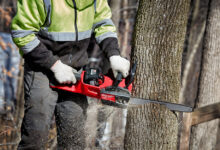Contents
- 1 Introduction: The Importance of Precise Fuel Mixing for Chainsaw Performance
- 2 Understanding the Importance of Mixing Ratios
- 3 Selecting the Right Fuel and Oil for Your Chainsaw
- 4 Mixing Process: Step-by-Step Instructions
- 5 Avoiding Common Mishaps during Fuel Mixing
- 6 Table: Chainsaw Fuel Mixing Ratios for Common Engine Sizes
- 7 FAQs: Addressing Common Concerns about Chainsaw Fuel Mixing
- 8 Conclusion: Optimizing Chainsaw Performance through Precise Fuel Mixing
Introduction: The Importance of Precise Fuel Mixing for Chainsaw Performance
Chainsaws are essential tools for various outdoor tasks, from felling trees to pruning branches. Their efficient operation relies heavily on the proper mixing of fuel and oil, a crucial step that can impact performance, lifespan, and operator safety. Understanding the intricacies of fuel mixing is paramount to maximize chainsaw functionality and minimize potential hazards. This comprehensive guide will delve into the essential aspects of chainsaw fuel mixing, providing detailed tips and guidelines to ensure optimal performance and longevity of your chainsaw.
Understanding the Importance of Mixing Ratios
The fuel-to-oil ratio in a chainsaw must be precise to achieve optimal performance. Too little oil can lead to engine damage due to insufficient lubrication, while too much oil can cause excessive smoking, fouling of spark plugs, and poor engine response. The recommended fuel-to-oil ratio for most chainsaws is 50:1, which means 50 parts gasoline to 1 part oil.
Selecting the Right Fuel and Oil for Your Chainsaw
The choice of fuel and oil for a chainsaw varies depending on the model and manufacturer’s recommendations. Generally, unleaded gasoline with a minimum octane rating of 89 is recommended for chainsaws. Using higher-octane fuel will not improve performance but can increase fuel consumption and emissions. As for oil, it is crucial to use a two-cycle engine oil specifically designed for chainsaws. Automotive oils are not suitable for chainsaws as they can cause carbon buildup and premature engine wear.
Mixing Process: Step-by-Step Instructions
Mixing fuel and oil for a chainsaw is a simple process, but it’s essential to follow the steps carefully to ensure accurate measurements and avoid spillage:
1. Determine the required amount of fuel and oil based on the fuel tank capacity and recommended fuel-to-oil ratio.
2. Measure the necessary amount of gasoline using a graduated container or measuring cup.
3. Add the required amount of chainsaw oil to the gasoline.
4. Shake the fuel container thoroughly to ensure thorough mixing of fuel and oil.
Avoiding Common Mishaps during Fuel Mixing
During fuel mixing, it’s crucial to avoid certain common mistakes that can compromise the performance and longevity of your chainsaw:
1. Using the wrong fuel-to-oil ratio: Incorrect mixing ratios can lead to engine damage or poor performance.
2. Using old or contaminated fuel: Stale fuel can cause carburetor issues and performance problems.
3. Using the wrong type of oil: Automotive oils are not suitable for chainsaws and can damage the engine.
4. Overfilling the fuel tank: Filling the fuel tank to the brim can cause fuel spillage and flooding of the carburetor.
5. Mixing fuel and oil in the chainsaw itself: Mixing fuel and oil directly in the chainsaw can lead to inaccurate measurements and potential spillage.
Table: Chainsaw Fuel Mixing Ratios for Common Engine Sizes
| Engine Size | Fuel-to-Oil Ratio |
|—|—|
| 25 cc | 50:1 |
| 35 cc | 40:1 |
| 45 cc | 32:1 |
| 55 cc | 25:1 |
| 65 cc | 20:1 |
FAQs: Addressing Common Concerns about Chainsaw Fuel Mixing
1. **What happens if I use too little oil?** Too little oil can lead to insufficient lubrication, causing engine damage and premature wear.
2. **What happens if I use too much oil?** Excessive oil can foul spark plugs, increase smoking, and reduce engine performance.
3. **Can I use automotive oil in my chainsaw?** No, automotive oils are not suitable for chainsaws and can damage the engine.
4. **How often should I mix fresh fuel?** Stale fuel can cause carburetor problems, so it’s recommended to mix fresh fuel every 30 days or after each use.
5. **How do I dispose of leftover fuel?** Leftover fuel should be disposed of properly at a designated waste disposal facility to avoid environmental contamination.
6. **What are the signs of a lean fuel mixture?** A lean fuel mixture can cause overheating, power loss, and engine damage.
7. **What are the signs of a rich fuel mixture?** A rich fuel mixture can cause excessive smoking, fouled spark plugs, and difficulty starting the engine.
8. **Can I use ethanol-blended fuel in my chainsaw?** Yes, you can use ethanol-blended fuel with up to 10% ethanol, but make sure to check the manufacturer’s guidelines.
9. **How do I store chainsaw fuel properly?** Chainsaw fuel should be stored in a cool, dry place away from direct sunlight to maintain its quality.
10. **What is the recommended storage period for chainsaw fuel?** Chainsaw fuel should be stored for no more than 30 days to prevent degradation and potential carburetor issues.
11. **How do I clean a carburetor that has been clogged by old fuel?** A clogged carburetor requires disassembly and cleaning with carburetor cleaner or compressed air.
12. **What are some safety precautions to observe when mixing and handling chainsaw fuel?** Wear gloves and eye protection, avoid spills, and mix fuel in a well-ventilated area.
13. **Where can I find the recommended fuel-to-oil ratio for my specific chainsaw model?** Refer to the owner’s manual for the specified fuel-to-oil ratio for your chainsaw model.
Conclusion: Optimizing Chainsaw Performance through Precise Fuel Mixing
By adhering to the principles outlined in this guide, you can ensure proper fuel mixing for your chainsaw, maximizing performance, extending lifespan, and minimizing potential safety hazards. Remember to follow the recommended fuel-to-oil ratio, select the correct fuel and oil, and mix fuel and oil according to the step-by-step instructions. By avoiding common missteps and addressing concerns through the FAQs provided, you can ensure your chainsaw operates at its peak and delivers reliable performance for years to come.









